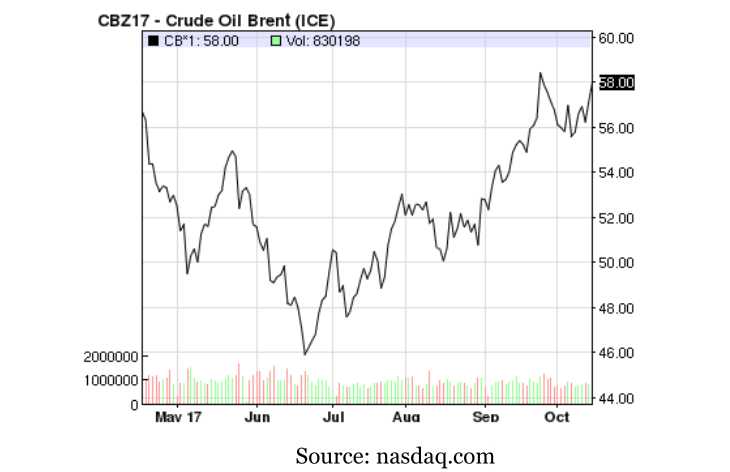Radu Dudău, EPG Director
Early September saw the beginning of a significant price increase for Brent, the international crude oil benchmark, which rose from $53/bbl to $59/bbl, the highest level since July 2015. As shown in the chart below, the growth has been almost 30% from June’s low-point of less than $46/bbl.

In an oil market analysis of April this year, I was wondering whether the OPEC agreement of November 2016 to cut supplies by 1.2 million barrels per day (mb/d) – to which Russia added an output cut of its own of 0.6 mb/d – would suffice to reign in the global oil glut that had built up and return the market to backwardation (i.e., a situation in which short-term delivery contracts are more expensive than longer-term futures).
Half a year later, the answer looks positive. There have been obvious effects of the output cut deal. Indeed, on October 5 (just a few weeks before the November 30 OPEC summit this year), Saudi Arabia responded with interest to the Russian proposal of extending the agreement until the end of 2018, while keeping the option of being “flexible.”
Yet other factors have also been active in driving up the oil market – both fundamental and contingent ones. The demand side has done most of the work. While one year ago concerns were expressed about oil demand from China and India, the recent months have seen robust (though gradually decreasing) imports from China, as Beijing has been building up strategic petroleum stocks in preparation for future market volatility.
More surprisingly and more consequential, though, are September figures from the IEA showing that shortly after the oil price collapse of the late 2014, oil consumption in the OECD countries started to grow solidly in the wake of whole decade of decline. OECD oil demand dropped from 50.4 mb/din 2005 to 45.4 mb/d in 2014 on account of high fuel prices, only to pick up in early 2015 at an average annual pace of about 400,000 b/d, as underscored by the FT.
For the whole 2017, IEA’s Oil Market Report for September estimates a “very strong growth year-on year” of 2.3 mb/d (2.4%), particularly in Europe and the U.S. In a condensed explanation, “OECD oil demand benefited from a rebound in economic activity and world trade, lower oil prices, and one-off elements boosting the year-on-year comparison.”
This will do away with much of the fuel demand reduction achieved in OECD since the 2008 economic crash – reduction partly driven by governmental policies aimed at energy efficiency targets – as consumer appetite for highly energy efficient cars lowers in a cheap oil context.
As to the contingent, “one-off elements” that added to the recent oil price increase, most widely mentioned was Recep Tayyip Erdogan’s warning of Iraqi Kurdistan, on September 24, that a declaration of independence on their part would be met with shutting off the Kirkuk-Ceyhan oil pipeline, the Kurdish region’s effective economic lifeline, which transports 550,000 b/d of crude to Turkey’s Mediterranean port of Ceyhan. Erdogan’s ominous words, “We have the tap. The moment we close the tap, then it’s done” is a stark reminder of the geopolitical risks surrounding international oil and gas pipelines.
Meanwhile, the devastating hurricane season of the late summer has caused a massive need for reconstruction on U.S.’s southern coast and in the Caribbean, which will surely result in increased petroleum demand.
On the supply side, the American shale producers were quick to lock in the latest oil price gains by means of options and swap contracts, given that $50 a barrel of WTI is deemed to be the breakeven price for most shale oil companies. According to FT, the selling positions in WTI crude totaled 473 mb by mid-September, the highest level of hedging since late 2014, and 86 mb more than at the end of August 2017. Thus, shale producers are in a good position to intensify drilling in the coming months. At the same time, though, too much short selling can bring the market back into contango, thus putting a break on the oil’s rallies.
All in all, as summed up by IEA, “analysis of the global balance shows that… for 2017 as a whole stocks will fall by 0.3 mb/d. This assumes OPEC crude oil production remaining at 32.5 mb/d. [W]e can clearly see a major reduction in floating storage, oil in transit, and stocks held in some independent areas. In the OECD, the five- year average stock overhang is now down to 170 mb from 318 mb at the end of January and stocks have fallen in months when they normally increase, offsetting net builds in China.”
Is this a turning point towards substantially higher oil prices? Most likely not. The same rebalancing mechanism of shale oil producers kicking in at higher crude prices will be prompted. However, we may well see a longer-lived equilibrium around $60 a barrel of Brent, which can make everyone happy for a couple of years.
